Background
I had the great honor to provide weather support for the Air Force’s role in the D-Day 60th Anniversary Airdrops in Normandy. I stayed for the most part
at Cherbourg’s airport at Maupertus (east of Cherbourg at the NW tip of France). The invasion beaches were to our east and southeast. Here’s some pictures from this important occasion.
Cherbourg Operations
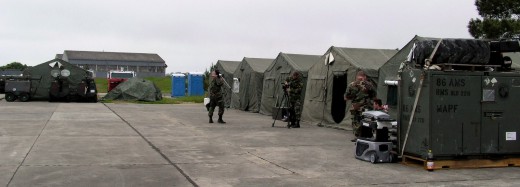 Tents where everyone on the airfield worked and slept. Tents where everyone on the airfield worked and slept.
|
|
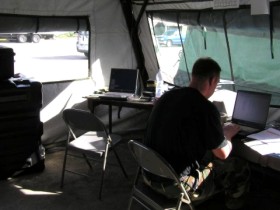 |
The tent I worked in – that’s my laptop in the corner. |
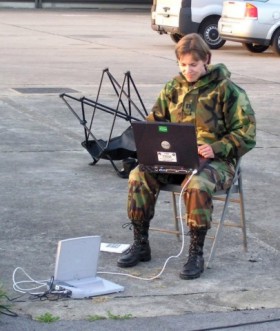 |
I got to give a new satellite receiver (the little gray box on the left) its first operational test. It allowed me to patch into the internet with nothing else. Although I could use an ethernet line that ran into the tent, it caused radio interference and I had to use my much shorter USB cable to get data.This is me on the day of the airdrops, preparing the briefing. Shortly after this picture, I was showing the General in charge of the airdrop satellite images on my laptop. |
 |
A C-17 coming in for a landing a couple of days prior to our mission. Our airfield was “sleepy hollow” until that morning, when heavy fog delayed the arrival of several aircraft.When it lifted, they were low on fuel and had to land right away. It was pretty chaotic and noisy with planes landing right after each other. |
Saint Mere Eglise
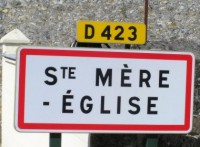 |
The street sign for the village that welcomed us so warmly. There were huge festivities and kids were walking around everywhere asking for autographs and souvenirs from the Americans. |
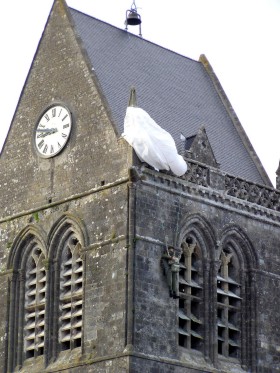 |
The church steeple where a paratrooper had hung up in the tragic misdrop that brought them right into the hands of the Germans instead of the countryside to the east.The depiction in “The Longest Day” was fairly accurate – the trooper was shot a few times while he struggled to free himself before he decided to play dead and eventually was cut down and survived. |
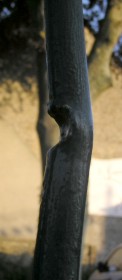 |
A bullet ricocheted off this railing of a fence when Germans were firing at the falling paratroopers. The man who lived in the house at the time (in the background) came and pointed it out to us. |
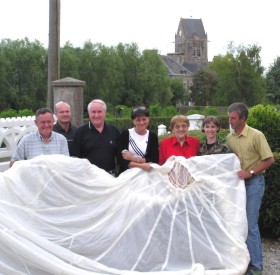 |
There is a tradition every year in St Mere Eglise to host any military members or veterans for dinner a couple of nights before D-Day. I was honored to participate, and ate with a family just down the road from the church.The father (on the left) and his wife (in red) were 14 and 12 on that day and lived in the country. The remembered the night well, and he had saved a parachute that had fallen. It was in perfect shape, and we took a picture with it here. |
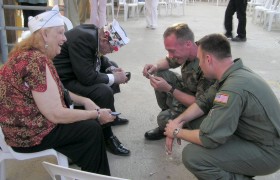 |
There was also a large hall near the town’s war museum that was a meeting place for all the veterans. We enjoyed going there to hear there stories, and they loved telling them. Here’s a couple of friends with a couple from Oklahoma. They’re looking at pictures of him 60 and about 50 years ago when he was a sergeant. |
D-Day Airdrops (5 June, Iron Mike Drop Zone)
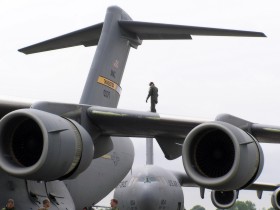 |
An aircrew member checks the wing of his C-17 for any problems. |
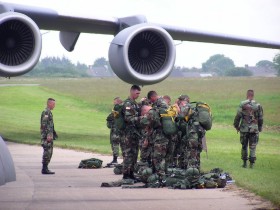 |
Paratroopers helping each other suit up. |
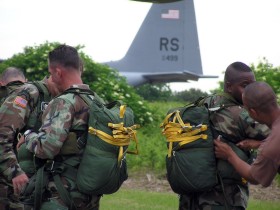 |
More paratroopers with a Ramstein C-130 tail in the background.This jump was made “Hollywood” with no extra gear. Usually they wear jumpsuits with tons of pockets for gear and have a huge rucksack on a tether to drop once their chute opens. |
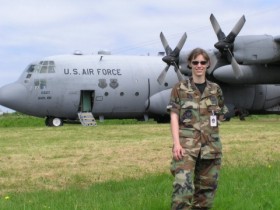 |
Moi standing in front of the lead plane – a C-130 from Dobbins AFB. The general in charge of the op was on board. |
 |
All 4 C-17’s lined up on the ramp. |
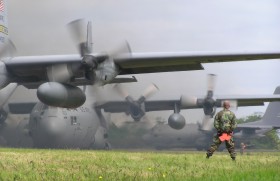 |
A marshaller standing by to give the planes a go. Imagine the sound of 48 propellers and 16 jet engines! |
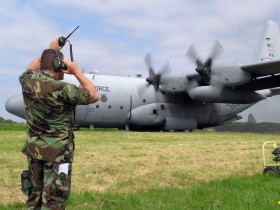 |
Time to roll! |
 Nine of the twelve C-130’s ready to take off in 15-second intervals. Nine of the twelve C-130’s ready to take off in 15-second intervals.
|
|
 Taking off – there’s 3 planes in the image. Taking off – there’s 3 planes in the image. |
|
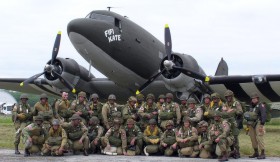 |
Here’s a crew of re-enactors that were about to drop out of a C-47 right before the modern day jump. I talked to a few of the guys, and some of them were Army on leave to participate. |
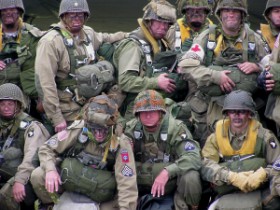 |
A close-up of this “Band of Brothers.” |
The Beaches
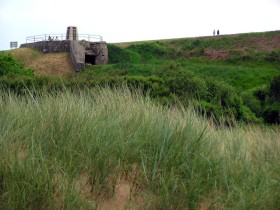 |
Omaha was the first beach I saw, and this is looking up from the edge toward a bunker. Bloody Omaha (the beach in “Saving Private Ryan”) must have been terribly difficult because of the steep terrain the troops had to navigate while under heavy fire from perfectly intact bunkers. |
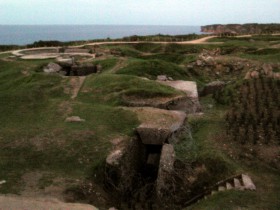 |
Later that same night, I saw Ponte du Hoc. The Rangers had to scale the steep cliffs to take out the important guns that were equidistant between Utah and Omaha beaches. It suffered a heavy aerial bombardment before the assult, and the ground still shows the upheaval with numerous craters and collapsed bunkers. |
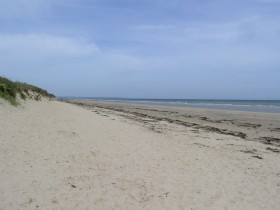 |
I stayed at Utah beach a couple of nights, so have a couple more pictures of it. Here’s a shot at its normal state. |
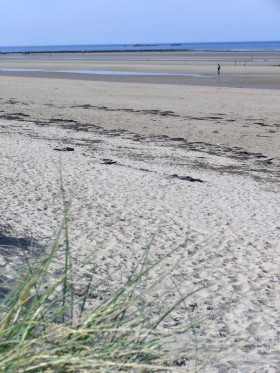 |
Here’s Utah at low tide like the day it was attacked. The criteria for the assult was a relatively full moon for the airdrops, but low tide near sunrise so the numerous obstacles and mines along the beach would be exposed. Unfortunately, that made for a very long run for the soldiers under fire. |
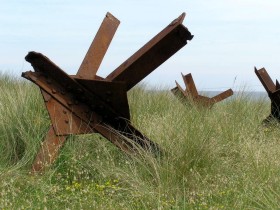 |
The rusty remnants of the beach obstacles. |
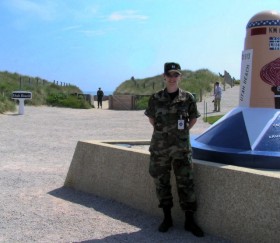 |
Me standing next to a memorial – mile 0. There were markers every mile from this point showing the distance to Paris. |
The American Cemetery, Omaha Beach
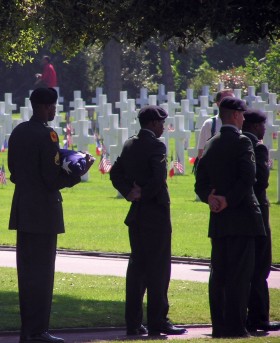 |
An Army color guard holds the American flag after a retreat ceremony at the Omaha Beach cemetery. |
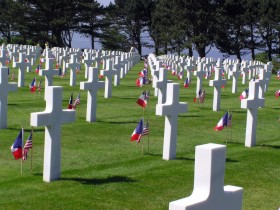 |
The symmetry and precision involved in laying the marble gravestones was incredible. |
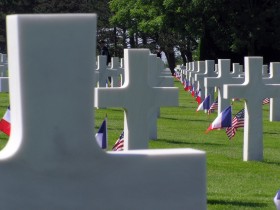 |
There was apparently no order to the way people were buried. One has to look up the names of loved ones at the visitors center, and they give the plot location. |
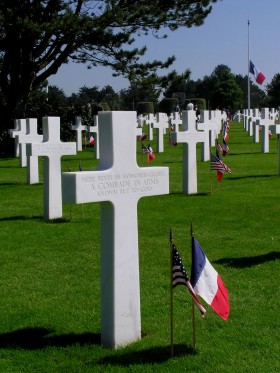 |
This is one of many, many unknown soldier stones. It reads: “Here rests in honored glory a comrade in arms known but to God.”There was an enormous courtyard with the names of missing soldiers and airmen. Many of them were probably buried here, but were never identified. |


